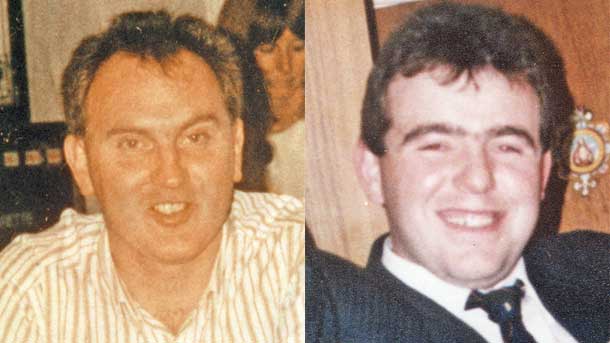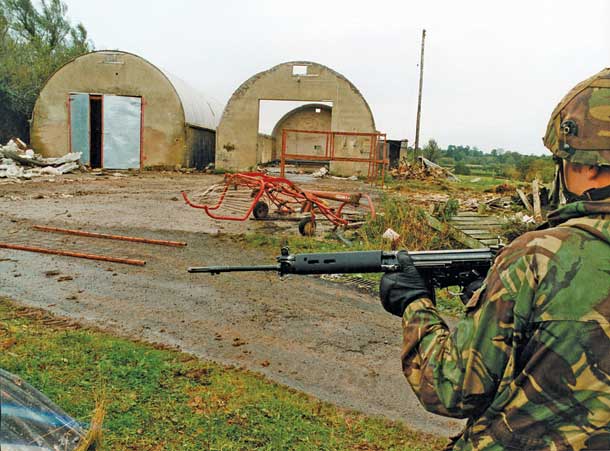25 May 2012 Edition
SAS licence to kill
SHOT 22 TIMES AND LAY DYING BUT SAS STILL FIRED INTO HIM TWICE MORE

IRA Volunteers Dessie Grew (top) and Martin McCaughey
Even though the severity of Dessie Grew’s injuries were obvious, Soldier D fired two more rounds into him, claiming he “felt under threat” despite Grew’s 22 bullet wounds. Soldier D alleged that Grew made a noise and moved towards his gun when he shot him.
AN SAS soldier fired two shots into the prone body of a fatally wounded IRA Volunteer who had already been shot 22 times yet the SAS actions have been accepted by an inquest jury as “reasonable force”.
Reacting angrily to the inquest’s ruling in May on the killings of IRA Volunteers Dessie Grew and Martin McCaughey in October 1990, Sinn Féin MLA Francie Molloy said:
“One irrefutable fact was established: the British state used lethal force to execute two Irish citizens in their own country. To describe this as reasonable is an outrage.”
IRA Volunteers Dessie Grew and Martin McCaughey were ambushed in a shoot-to-kill operation by a unit of the British Army’s elite SAS at isolated farm buildings near Loughgall, County Armagh, on 9 October 1990.
Four British soldiers (known in evidence by the letters A, B, C and D) claimed they opened fire on the Volunteers as they approached them because they believed their lives were in danger.
Both the IRA men suffered multiple wounds in the sustained bursts of gunfire.
Grew was hit 22 times while McCaughey was shot 10 times.
Even though the severity of Dessie Grew’s injuries were obvious, Soldier D fired two more rounds into him, claiming he “felt under threat” despite Grew’s 22 bullet wounds. Soldier D alleged that Grew made a noise and moved towards his gun when he shot him.
The inquest jury decided that Soldier D’s decision to fire into the mortally wounded Grew “was reasonable”.
Fearghal Shiels of solicitors Madden and Finucane was critical of the jury, saying it failed to deal with crucial aspects of some of the evidence.
“In dealing with the shooting of Dessie Grew, Soldier ‘A’ said that one of his unit had shot Grew not because he presented any threat but because he showed ‘signs of life’.
“That was a clear and unequivocal account of the unjustified shooting of a wounded man which occurred after ‘A’ had ordered a ceasefire.
“Soldier D, who administered what was effectively a coup de grace to Dessie Grew, could have kicked away his weapon had he genuinely believed that he posed any threat.”
Challenging the jury’s findings that the SAS had only opened fire on the IRA men as they walked towards their position, the solicitor said:
“Two pathologists, Dr Derek Carson (former Assistant State Pathologist) and Dr Nat Cary both gave agreed evidence that the only wound which Martin McCaughey positively sustained whilst upright had entered his back and exited his chest.
“Clearly, McCaughey was not facing the soldiers when he sustained that wound and clearly therefore was not advancing towards soldiers when he was shot.
“Both pathologists agreed that the remainder of his wounds were not inconsistent with him having being shot whilst on the ground and that he received a fatal head wound from a position in which no soldier admits to having fired a shot.”
The families also rejected the jury’s verdict and questioned why key evidence was withheld from the inquest.
Martin McCaughey’s brother, Peter, said: “We had fought for more than 20 years to get an inquest which could deliver an effective verdict.
“My father, Owen, successfully took the Chief Constable all the way to the House of Lords to ensure that the PSNI handed over all documents concerning Martin’s and Dessie’s deaths.
“Yet not a single police or British Army log, which would have contained crucial contemporaneous information concerning the killings, could be apparently found.”
In 2011, McCaughey’s mother, Brigid, went to the Supreme Court to force the PSNI and British Army to explain what plans they had made to arrest the two IRA men.
Peter McCaughey said that despite this allegedly being an arrest operation, not one soldier who gave evidence could articulate what the plan was “and the jury has failed to deal properly with that”.
During the inquest, Mrs McCaughey was forced to take another legal challenge to ensure the families’ legal team were allowed to question the SAS soldiers about their involvement in previous fatal killings in the North of Ireland.
Soldier A, who led the SAS unit that shot Grew and McCaughey, had previously been involved in the shooting dead of another IRA man, Francis Bradley, four years earlier.
Soldier A initially gave evidence at the inquest but failed to return to the hearing after it was ruled he could be questioned about his involvement in the Francis Bradley shooting and evidence appearing to show that all three IRA men had been shot while lying fatally wounded on the ground.

The scene of the killing where Volunteers Dessie Grew and Martin McCaughey were shot dead at an agricultural shed in rural County Armagh




